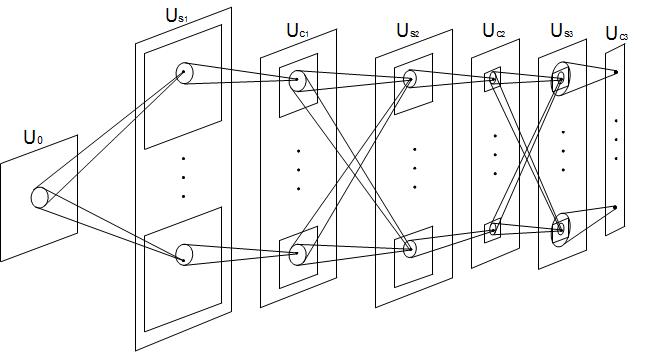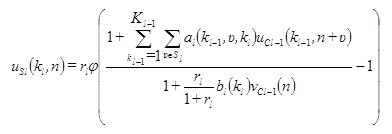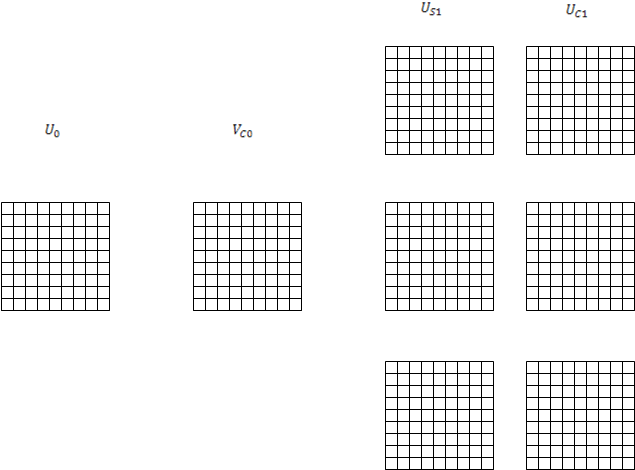Abstract
Contents
- Introduction
- 1. Theme urgency
- 2. Goal and tasks of the research
- 3. Overview of researches and developments
- 3.1 International sources overview
- 3.2 National sources overview
- 3.3 Local sources overview
- 4. Neocognitron-type neural network model
- Conclusion
- References
Introduction
The artificial neural networks currently becoming an effective instrument for solving complex problems of pattern recognition, management, prognostication etc. Among the varieties of different neural network architectures the highest hopes are for multilayered neocognitron-type neural networks. The architecture of this system is developed after the organization of human's visual system. The first neocognitron model was developed in 1980 by Japanese scientist K. Fukushima [1] specifically for solving pattern recognition tasks that are a subject to various distortions. Later developments of cognitron neural network were initiated by this very model [2].
The architecture of neocognitron-type network is significantly more complicated than that of a traditional neural network. For that reason, neocognitron model requires comprehensive tuning for every specific task. The quality of neuron network solution for a recognition problem largely depends on understanding the functioning principles of a multiparameter neocognitron architecture. The examples of solving the pattern recognition problems are considered in the works [3, 4, 5]. Unsolved questions include lack of precise formulation and solutions for the problem of multiple parameter optimization of neocognitron that are adequate to the nature of graphic and visual images being recognized.
It is known that the most effective way of understanding a complete process is modeling. In our case we need to build a program neocognitron model that will allow us to monitor influence of its multiple parameters on the quality of recognition. Therefore, the purpose of this article is developing a program emulator of multilayered neural network with neocognitron architecture.
1. Theme urgency
The task of human face recognition is of a great importance nowadays, because it is used in real systems of automatic control and security. In theory, the proposed recognition methods do not provide required quality. The big perspectives of improving a recognition quality are usually linked to usage of neural networks (neocognitron in particular) that are not yet reseached and tested enough.
2. Goal and tasks of the research
This work's task is developing a system of neural network recognition to recognize a person's face using an image taken by video camera.
The main tasks of research:
- Analysis of existing neural network models of pattern recognition
- Development of learning and recognizing algothythms based on a neurocognitron-type neural network
- Determination of neocogniton architecture that is oriented on recognition of human face images
- Development of program model of a neural network recognizer
- Efficiency evaluation of neural network recognizer of face images captured by camera in real-time
After completing this work, obtaining of the following scientific results is planned:
- Parametric model of neocognitron-type multilayered neural network
- Neocognitron structural model
- Neocognitron program model in object-oriented presentation
- Evaluation of quality of neural network human face recognition
- Connection modules of video camera image input, distinguishing and recognizing faces
- Analyzing the efficiency of face recognition in real-time
3. Overview of researches and developments
The issue of face recognition is quite topical in the modern world, because a lot of scientists worldwide are involved in work on it. One of the most promising approaches regarding face recognition is the use of mulitlayered neural networks. Neocognitron appears to be one of the most perspective neural networks. The most of scientific articles on the issue have been published in Japan, although there are other publications from several countries in existance.
3.1 International sources overview
Neocognitron was developed by Japanese scientist K. Fukushima [6] and currently being improved by him and his colleagues [1, 7, 18]. The most common use of neocognitron is for recognizing hand-written text [8, 10, 13, 16], but it could also be used for recognizing vehicle plate characters [20]. There are realizations of parallel face recognitions systems using neocognitron as well [21].
In an article [20], a further development of improved neocognitron algorhythm is proposed, particularly layer's dimension regulation, threshold function and connected Gaussian kernel estimation. There are also comparisons to other character recognition methods based on neocognitron-type neural networks. The proposed neocognitron version is applied to the task of recognition of vehicle plate characters.
Article [21] is notable because it implements a neocognitron algorhythm for face recognition based on a high-performance graphic processor architecture using CUDA technology.
3.2 National sources overview
There are multiple universities in Ukraine that work on the issue, such as Kharkov National Radionics University [22, 23, 24], National Technical University [25], Kharkov Air Force University [26], Vinnytsa National Technical University [27], Chernigov National Technological University [28] and others.
3.3 Local sources overview
In Donetsk National Technical University the problem of pattern recognition is researched at the Department of applied mathematics and informatics. In particular, neural network approaches to the issue are studied by docent Fedyaev O.I. [29–34], the face recognition distribution systems are being reviewed in the works of docent Ladyzhensky Yu.V. [35, 36]
3. Neocognitron-type neural network model
Neocognitron is a hierarchical neural network, consisting of plenty big amount of layers that follow each other and have incomplete (and rather rare) connections between the each other. The simplified neocognitron structure is presented on Picture 1. It depicts three modules of neural network, each one of them having two types of layers: the simple
ones (S-layers) or complex
ones (C-layers), that contain either simple (recognizing input information) or complex (generalizing output information) planes, respectfully. To simplify the picture, planes with inhibitory neurons are not shown.
The following structure shows that size of the first layer matches the size of the input image (U0) and the closer it gets to the last layer, the smaller are the plane sizes. The last layer of each plane contains only one neuron.

Picture 1 – The structure of multilayered neocognitron-type neural network
For calculating output signals of the S-plane neurons the following formula is used:

In this formula the inhibitory plane  output signals are considered, which are calculated using the following formula:
output signals are considered, which are calculated using the following formula:

On the set-theoretic level the parametric model of multilayered neocognitron (NC) can be presented as a tuple:

where L – the amount of modules in neocognitron; l – the module's number, 1≤ l ≤L;  – the amount of planes in a single layer (S or C) of l-module; Х, Y – neocognitron inputs (outputs) for reception (capture) of an input (output) signal;
– the amount of planes in a single layer (S or C) of l-module; Х, Y – neocognitron inputs (outputs) for reception (capture) of an input (output) signal;  – weight coefficient of m-input connection of (ij) neuron р-plane S-layer l-module with ν-neuron output (
– weight coefficient of m-input connection of (ij) neuron р-plane S-layer l-module with ν-neuron output ( – neuron coordinates in connection area);
– neuron coordinates in connection area);  – connection area on p-plane С-layer (l-1)-module;
– connection area on p-plane С-layer (l-1)-module;  – weight coefficient of n-input (ij) neuron р-plane С-layer l-module with ν-neuron output from its receptive area (
– weight coefficient of n-input (ij) neuron р-plane С-layer l-module with ν-neuron output from its receptive area ( );
);  – (ij) neuron connection area located on р-plane S-layer lmodule.
– (ij) neuron connection area located on р-plane S-layer lmodule.
In S and C layers of each neocognitron module there are inhibitory neurons that are marked in a tuple by parameters  ,
,  . These are constant coefficients of inhibitory input for all neurons related to layers S and С of l-module. The basic neuron activation functions are marked as
. These are constant coefficients of inhibitory input for all neurons related to layers S and С of l-module. The basic neuron activation functions are marked as  and as
and as  , and the inhibitory neurons activation functions as
, and the inhibitory neurons activation functions as  and as
and as  .
.
Parametric model and multilayered structure of neocognitron with consequent connections allows us to get a functional dependence of output signals of Y network from it output Х signals:

For teaching this network an unsupervised learning
strategy is used. For this task we have to use a complicated scheme of choosing a representative
– a neuron that shows the biggest output signal. This scheme is described in detail in article [1] in chapter 4.2.
As a result of teaching, the weight coefficients are being tuned to distinguish specific features of input image. The recognizing process can be demonstrated using an example of recognizing the simplest graphical primitives (vertical, horizontal, diagonal).

Picture 2 – The process of recognition of input patterns
(animation: 15 frames, 7 cycles of repeating, 120 kilobytes)
Picture 2 depicts a simplified neocognitron model:  – input layer,
– input layer,  – plane with inhibitory neurons,
– plane with inhibitory neurons,  – S-layer, consisting of S-neuron planes,
– S-layer, consisting of S-neuron planes,  – C-layer, consisting of C-neuron planes. Neocognitron's entry receives consequent images that react on different neuron planes.
– C-layer, consisting of C-neuron planes. Neocognitron's entry receives consequent images that react on different neuron planes.
Conclusion
During the research, it was determined that in order to provide the effective teaching and recognizing results, neocognitron requires a precised tuning of neural network parameters. Accurate analysis is required for each particular task in order to determine the optimal values of such parameters as: the amount of modules, the dimension of neuron connection area, each layer's teaching speed and the amount of planes in modules.
During the research the following tasks were completed:
- Parametric model of neocognitron-type neural network has been developed
- Structure neocognitron model has been built
- Program model of neocognitron has been developed
Further researches are directed at the following aspects:
- Evaluation of quality of neural network human face recognition
- Connection modules of video camera image input, distinguishing and recognizing faces
- Analyzing the efficiency of face recognition in real-time
Writing this summary does not mean the completion of master's work. The date of final completion: December 2013. The full text and additional materials regarding the subject can be received from author or his supervisor after the above-mentioned date.
References
- Fukushima K., Miyake S. Neocognitron: a new algorithm for pattern recognition tolerant of deformations and shifts in position – Pattern Recognition Vol. 15, No 6, 1982. – pp. 455-469
- Уоссермен Ф. Нейрокомпьютерная техника. Теория и практика. – М.: Мир, 1992
- Руденко О.Г., Бодянский Е.В. Основы теории искусственных нейронных сетей. Уч. пособие. – Харьков: ТЕЛЕТЕХ , 2002. – 317 с.
- Федяев О.И. Куликов С.А. Применение многоуровневых нейронных сетей типа неокогнитрон для распознавания символов // Сб. тр. междунар. науч. конф. «Нейросетевые технологии и их применение». – Краматорск: ДГМА, 2003. – С. 247-256
- Федяев О.И., Махно Ю.С. Распознавание графических образов при наличии искажений с помощью неокогнитронных нейросетей // Тр. 8-й междунар. науч. конф. «Интеллектуальный анализ информации ИАИ-2008». – К.: Просвіта, 2008. – С. 512-521
- Fukushima K. Neocognitron: A Self-organizing Neural Network Model for a Mechanism of Pattern Recognition Unaffected by Shift in Position – Biol. Cybernetics 36, 1982. – pp. 193-202
- Fukushima K. Neocognitron: A Hierarchical Neural Network Capable of Visual Pattern Recognition [Электронный ресурс]. Режим доступа: http://hebb.mit.edu/courses/9.641/2006/readings/Fukushima88.pdf
- Fukushima K., Wake N. Handwritten alphanumeric Character Recognition by the Neocognitron – IEEE Transactions on neural networks, Vol. 2, No 3, 1991. – pp. 355-365
- Fukushima K. and Wake N. Improved Neocognitron with Bend-Detection Cells – IEEE International Joint Conference on Neural Networks, Baltimore, Maryland, 1992
- Fukushima K. Imagawa T. Recognition and Segmentation of Connected Characters With Selective Attention – Neural Networks, Vol. 6, 1993. – pp. 33-41
- Fukushima K., Okada M., Hiroshige K. Neocognitron With Dual C-Cell Layers – Neural Networks, Vol. 7, No 1, 1994. – pp. 41-47
- Fukushima K., Tanigawa M. Use of different thresholds in learning and recognition – Neurocomputing, Vol. 11, 1996. – pp. 1-17
- Fukushima K., Nagahara K., Shouno H. Training neocognitron to recognize handwritten digits in the real world – IEEE Computer Society Press, Silver Spring, MD, 1997. – pp. 292–298
- Fukushima K., Kimura E. and Shouno H. Neocognitron with Improved Bend-Extractors: Recognition of Handwritten Digits in the Real World – Neural Comput & Applic, 1998. – pp. 260-272
- Fukushima K. Self-organization of shift-invariant receptive fields – Neural Networks, Vol. 12., 1999. – pp. 791–801
- Fukushima K. Neocognitron for handwritten digit recognition – Neurocomputing, Vol. 51, 2003. – pp. 161–180
- Fukushima K. Neocognitron capable of incremental learning – Neural Networks, Vol. 17, 2004. – pp. 37–46
- Fukushima K. Interpolating vectors for robust pattern recognition – Neural Networks, Vol. 20, 2007. – pp. 904–916
- Fukushima K. Increasing robustness against background noise: Visual pattern recognition by a neocognitron – Neural Networks, Vol. 24, 2011. – pp. 767-778
- Kangin D., Kolev G., Vikhoreva A. Further Parameters Estimation of Neocognitron Neural Network Modification with FFT Convolution – ISSN: 2180-1843, Vol. 4, No. 2, July – December 2012
- Gustavo Poli, José Hiroki Saito, João F. Mari, Marcelo R. Zorzan Processing Neocognitron of Face Recognition on High Performance Environment Based on GPU with CUDA Architecture – 20th International Symposium on Computer Architecture and High Performance Computing, 2008. – pp. 81-88
- Замула А.А., Косиковская Н.И., Землянко Ю.В. Биометрическая аутентификация по изображению лица на основе скрытых марковских моделей – Информационно-управляющие системы на железнодорожном транспорте, 2013. – С. 28-31
- Вечур А.В., Васильев А.Г. Реализация программной модели распознавания образа человека – Восточно-Европейский журнал передовых технологий // Научный журнал. – Харьков: Технологический центр, 2010. – №4/2 (46). – С. 64-66
- Путятин Е.П., Оробинский П.А. Построение 12-факторной модели человеческого лица – Бионика интеллекта, № 1 (72), 2010. – С. 12–17
- Ивашко А.В., Потапенко А.И. Алгоритмы выделения объектов на изображении – Вестник национального технического университета
ХПИ
// Сборник научных трудов, Тематический выпуск 57, 2011 - Берковский В.В., Свиридов А.А. Нейротехнологии как метод решения задачи распознавания образов – Сборник научных трудов Харьковского университета Воздушных Сил. – Харьков: ХУПС, 2012. – №1(30). – C. 93-95
- Квєтний Р.Н., Поремський Ю.В., Кулик О.А., Перегончук Р.О. Аналіз інформаційних технологій ідентифікації людських облич – Інформаційні технології та комп'ютерна інженерія, № 2, 2011. – C. 27-32
- Никитенко Е.В., Силиченко А.И. Структура системы идентификации человека по изображению лица – Вісник Чернігівського державного технологічного університету
Технічні науки
, №3(51), 2011 р. - Костецкая Г.Ю., Федяев О.И. Распознавание изображений человеческих лиц с помощью свёрточной нейронной сети – Інформаційні управляючі системи та комп’ютерний моніторинг – Донецьк, ДонНТУ, 2010. – C. 216-218
- Сова А.А., Федяев О.И. Исследование моделей S- и С нейронов неокогнитрона при обучении и распознавании образов – VII международная научно-техническая конференция студентов, аспирантов и молодых научных работников
Информатика и компьютерные технологии
– Донецк, ДонНТУ, 2011. – С. 164-168 - Умяров Н.Х., Костецкая, Г.Ю., Федяев О.И. Исследование алгоритма обучения сверточной нейронной сети в системе распознавания человеческих лиц – VIII международная научно-техническая конференция студентов, аспирантов и молодых научных работников
Информатика и компьютерные технологии
– Донецк, ДонНТУ, 2012. – С. 300-305 - Сова А.А., Федяев О.И. Математическая модель распознавания и обучения неокогнитрона – Інформаційні управляючі системи та комп’ютерний моніторинг – Донецьк, ДонНТУ, 2011
- Костецкая Г.Ю., Федяев О.И. Кодирование изображений человеческих лиц с помощью самоорганизующейся карты Кохонена – V международная научно-техническая конференция студентов, аспирантов и молодых научных работников
Информатика и компьютерные технологии
– Донецьк, ДонНТУ, 2009. – С. 265-268 - Умяров Н.Х., Федяев О.И. Выделение лица на снимке из видеопотока с целью его распознавания – VII международная научно-техническая конференция студентов, аспирантов и молодых научных работников
Информатика и компьютерные технологии
– Донецьк, ДонНТУ, 2011. – С. 173-177 - Колесник А.В., Ладыженский Ю.В. Распределенная программная система распознавания лиц – VI международная научно-техническая конференция студентов, аспирантов и молодых научных работников
Информатика и компьютерные технологии
– Донецьк, ДонНТУ, 2010. – С. 248-251 - Ларин Б.И., Ладыженский Ю.В. Распределенная программная система для распознавания лиц – VII международная научно-техническая конференция студентов, аспирантов и молодых научных работников
Информатика и компьютерные технологии
– Донецьк, ДонНТУ, 2011. – С. 146-149
